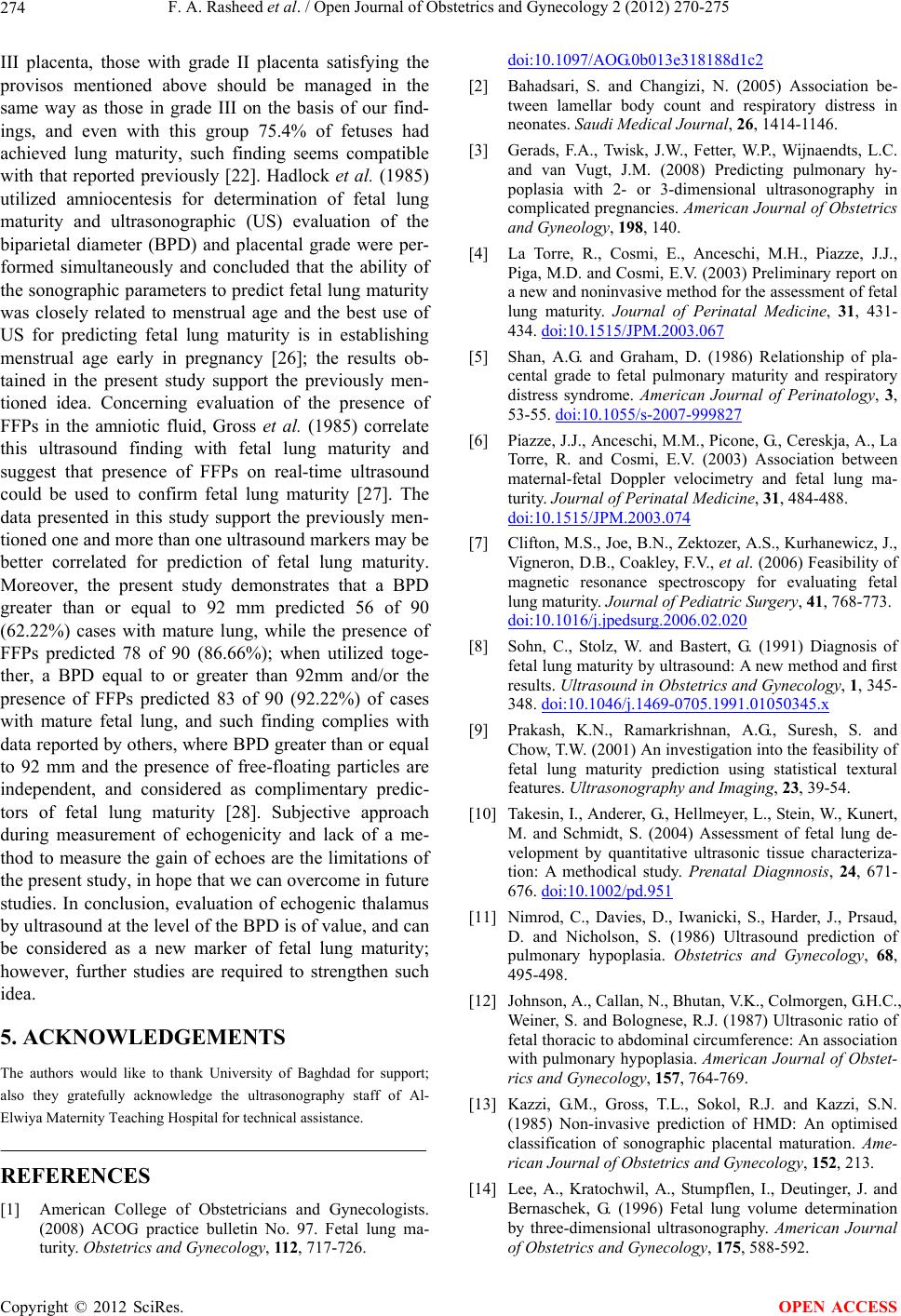
F. A. Rasheed et al. / Open Journal of Obstetrics and Gynecology 2 (2012) 270-275
274
III placenta, those with grade II placenta satisfying the
provisos mentioned above should be managed in the
same way as those in grade III on the basis of our find-
ings, and even with this group 75.4% of fetuses had
achieved lung maturity, such finding seems compatible
with that reported previously [22]. Hadlock et al. (1985)
utilized amniocentesis for determination of fetal lung
maturity and ultrasonographic (US) evaluation of the
biparietal diameter (BPD) and placental grade were per-
formed simultaneously and concluded that the ability of
the sonograph ic parameters to predict fetal lung maturity
was closely related to menstrual age and the best use of
US for predicting fetal lung maturity is in establishing
menstrual age early in pregnancy [26]; the results ob-
tained in the present study support the previously men-
tioned idea. Concerning evaluation of the presence of
FFPs in the amniotic fluid, Gross et al. (1985) correlate
this ultrasound finding with fetal lung maturity and
suggest that presence of FFPs on real-time ultrasound
could be used to confirm fetal lung maturity [27]. The
data presented in this study support the previously men-
tioned one an d more than on e u ltr asound mar k er s may be
better correlated for prediction of fetal lung maturity.
Moreover, the present study demonstrates that a BPD
greater than or equal to 92 mm predicted 56 of 90
(62.22%) cases with mature lung, while the presence of
FFPs predicted 78 of 90 (86.66%); when utilized toge-
ther, a BPD equal to or greater than 92mm and/or the
presence of FFPs predicted 83 of 90 (92.22%) of cases
with mature fetal lung, and such finding complies with
data reported by others, where BPD greater than or equal
to 92 mm and the presence of free-floating particles are
independent, and considered as complimentary predic-
tors of fetal lung maturity [28]. Subjective approach
during measurement of echogenicity and lack of a me-
thod to measure the gain of echoes are the limitations of
the present study, in hope th at we can overco me in future
studies. In conclusion, evaluation of echogenic thalamus
by ultrasound at the lev el of the BPD is of value, and can
be considered as a new marker of fetal lung maturity;
however, further studies are required to strengthen such
idea.
5. ACKNOWLEDGEMENTS
The authors would like to thank University of Baghdad for support;
also they gratefully acknowledge the ultrasonography staff of Al-
Elwiya Maternity Teaching Hospital for technical assistance.
REFERENCES
[1] American College of Obstetricians and Gynecologists.
(2008) ACOG practice bulletin No. 97. Fetal lung ma-
turity. Obstetrics and Gynecology, 11 2, 717-726.
doi:10.1097/AOG.0b013e318188d1c2
[2] Bahadsari, S. and Changizi, N. (2005) Association be-
tween lamellar body count and respiratory distress in
neonates. Saudi M ed ic al Journal, 26, 1414-1146.
[3] Gerads, F.A., Twisk, J.W., Fetter, W.P., Wijnaendts, L.C.
and van Vugt, J.M. (2008) Predicting pulmonary hy-
poplasia with 2- or 3-dimensional ultrasonography in
complicated pregnancies. American Journal of Obstetrics
and Gyneology, 198, 140.
[4] La Torre, R., Cosmi, E., Anceschi, M.H., Piazze, J.J.,
Piga, M.D. and Cosmi, E.V. (2003) Preliminary report on
a new and noninvasive method for the assessment of fetal
lung maturity. Journal of Perinatal Medicine, 31, 431-
434. doi:10.1515/JPM.2003.067
[5] Shan, A.G. and Graham, D. (1986) Relationship of pla-
cental grade to fetal pulmonary maturity and respiratory
distress syndrome. American Journal of Perinatology, 3,
53-55. doi:10.1055/s-2007-999827
[6] Piazze, J.J., Ancesc hi, M.M., Picone, G., Cereskja, A., La
Torre, R. and Cosmi, E.V. (2003) Association between
maternal-fetal Doppler velocimetry and fetal lung ma-
turity. Journal of Perinatal Medicine, 31, 484-488.
doi:10.1515/JPM.2003.074
[7] Clifton, M.S. , Joe, B.N., Zekt ozer, A.S., Kurhanewicz , J.,
Vigneron, D.B., Coakley, F.V., et al. (2006) Feasibility of
magnetic resonance spectroscopy for evaluating fetal
lung maturity. Journal of Pediatric Surgery, 41, 768-773.
doi:10.1016/j.jpedsurg.2006.02.020
[8] Sohn, C., Stolz, W. and Bastert, G. (1991) Diagnosis of
fetal lung maturity by ultrasound: A new method and first
results. Ultrasound in Obstetrics and Gynecology, 1, 345-
348. doi:10.1046/j.1469-0705.1991.01050345.x
[9] Prakash, K.N., Ramarkrishnan, A.G., Suresh, S. and
Chow, T.W. (2001) An investigation into the feasibility of
fetal lung maturity prediction using statistical textural
features. Ultrasonography and Imaging, 23, 39-54.
[10] Takesin, I., Anderer, G., Hellmeyer, L., Stein, W., Kunert,
M. and Schmidt, S. (2004) Assessment of fetal lung de-
velopment by quantitative ultrasonic tissue characteriza-
tion: A methodical study. Prenatal Diagnnosis, 24, 671-
676. doi:10.1002/pd.951
[11] Nimrod, C., Davies, D., Iwanicki, S., Harder, J., Prsaud,
D. and Nicholson, S. (1986) Ultrasound prediction of
pulmonary hypoplasia. Obstetrics and Gynecology, 68,
495-498.
[12] Johnson, A., Callan, N., Bhutan, V.K., Colmorgen, G.H.C.,
Weiner, S. and Bolognese, R.J. (1987) Ultrasonic ratio of
fetal thoracic to abdominal circumference: An association
with pulmonary hypoplasia. American Journal of Obstet-
rics and Gynecology, 157, 764-769.
[13] Kazzi, G.M., Gross, T.L., Sokol, R.J. and Kazzi, S.N.
(1985) Non-invasive prediction of HMD: An optimised
classification of sonographic placental maturation. Ame-
rican Journal of Obstetrics and Gynecology, 152, 213.
[14] Lee, A., Kratochwil, A., Stumpflen, I., Deutinger, J. and
Bernaschek, G. (1996) Fetal lung volume determination
by three-dimensional ultrasonography. American Journal
of Obstetrics and Gynecology, 175, 588-592.
Copyright © 2012 SciRes. OPEN ACCESS